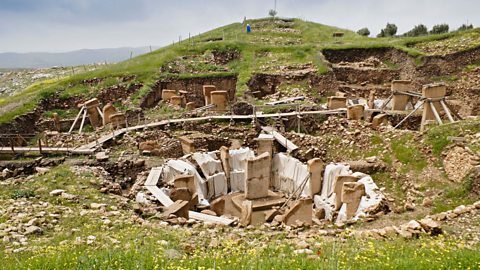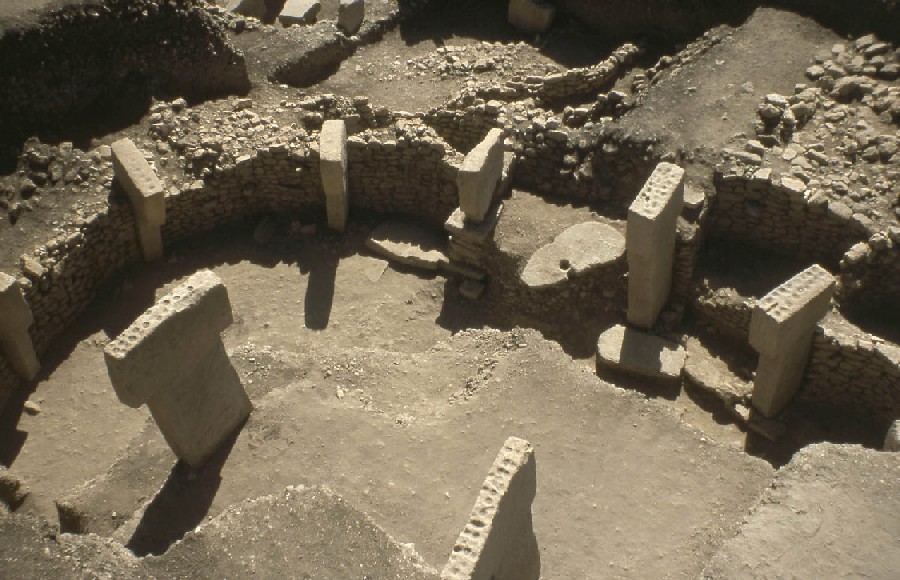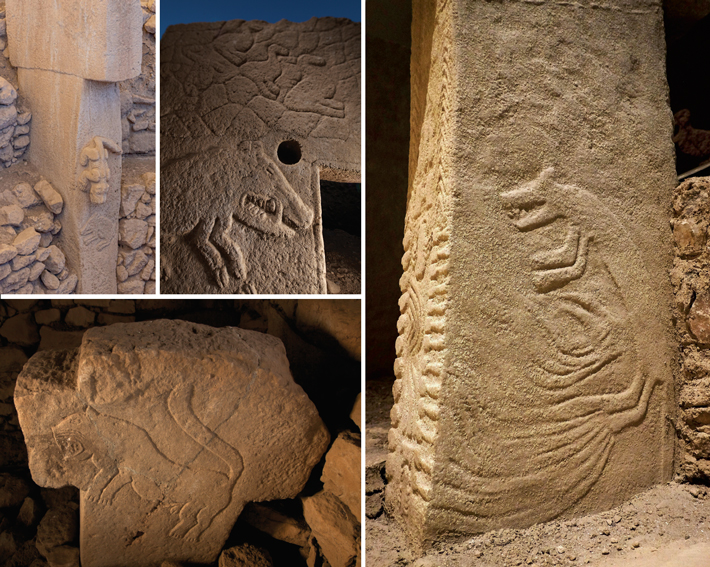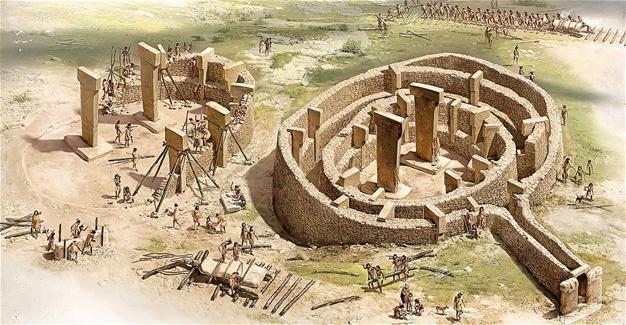Göbekli Tepe: Turkey's 11,000-Year-Old Mystery

Göbekli Tepe is an ancient archaeological site located in southeastern Turkey. It was first discovered in the 1960s by a team of researchers from the University of Chicago, but it wasn't until recent years that its true significance was realized. This remarkable site has challenged our understanding of human history and revolutionized our view of the development of complex societies.
Discovering Göbekli Tepe
The discovery of Göbekli Tepe was a remarkable breakthrough in archaeology. The site was found by chance during a survey by Klaus Schmidt and his team. They noticed a series of large stone pillars peeking out from the ground, and upon careful investigation, it was discovered that these pillars were part of a much larger complex.
Göbekli Tepe consists of several circular structures, known as "enclosures," which are made up of massive limestone pillars, some over 16 feet high. These pillars are intricately carved with intricate animal and human motifs. The sheer scale and complexity of the site indicate that it was not a simple hunter-gatherer settlement but a ceremonial or religious centre.
Importance of Göbekli Tepe in Archaeology
Göbekli Tepe is often called the world's oldest known temple, predating even the great pyramids of Egypt by thousands of years. Its existence challenges the traditional belief that complex societies emerged due to the development of agriculture. Instead, it suggests that the desire to build monumental structures and engage in religious rituals may have been the driving force behind the social organization and cooperation necessary for the development of civilization.
The carvings found on the pillars at Göbekli Tepe are significant to archaeologists. They depict various animals, such as lions, snakes, and spiders, as well as abstract symbols. These carvings provide a glimpse into the religious beliefs and mythologies of the people who lived at the site. Through careful analysis, researchers have gained insights into this ancient society's cultural and social practices.
Göbekli Tepe is an extraordinary archaeological site that has revolutionized our understanding of human history. It challenges traditional notions of societal development and provides valuable insights into our ancient ancestors' religious and cultural practices. The ongoing excavations at Göbekli Tepe will reveal even more fascinating discoveries, further expanding our knowledge of the past.
Excavation and Discovery of Göbekli Tepe
Uncovering the Ancient Monument
Göbekli Tepe was not immediately recognized for its historical significance when it was initially discovered in the 1960s. It took several decades for archaeologists to realize the true importance of this site. The credit for unearthing Göbekli Tepe goes to Klaus Schmidt and his team from the University of Chicago. While surveying southeastern Turkey, they stumbled upon large stone pillars jutting from the ground. They discovered that these pillars formed part of a more extensive and complex structure as they further explored the area. The excitement and mystery surrounding the site quickly grew.
The circular structures, called "enclosures," found at Göbekli Tepe are astounding in their construction. Composed of massive limestone pillars, some towering over 16 feet high, these enclosures have intricate carvings depicting various animals and mythical creatures. The attention to detail and the sheer scale of the site suggest that it was not just a settlement but something much more significant - possibly a religious or ceremonial centre.
Archaeological Findings and Dating Techniques
Göbekli Tepe's significance lies in its age and what it reveals about human history. The site predates even the pyramids of Egypt, challenging traditional notions of the development of complex societies. It offers a new perspective on the emergence of civilization, suggesting that it may have been driven by the desire to engage in religious rituals and build monumental structures.
The carvings discovered at Göbekli Tepe provide invaluable insights into the beliefs and mythologies of the ancient people who inhabited the site. Depictions of animals such as lions, snakes, and spiders, alongside abstract symbols, offer a glimpse into their religious and cultural practices. Through careful analysis, researchers have been able to piece together fragments of this ancient society's way of life.
Archaeologists employ various dating techniques to determine the age of Göbekli Tepe. Radiocarbon dating has revealed that the structures were built between 9600 and 7300 BCE. Furthermore, the enclosures' arrangement and the architectural style change over time, suggesting deliberate planning and advancement in construction techniques.
The excavation and discovery of Göbekli Tepe have fundamentally reshaped our understanding of human history. This ancient site challenges our preconceived notions of societal development and offers glimpses into our ancient ancestors' religious and cultural practices. Ongoing excavations will continue to unearth new revelations, expanding our knowledge of this remarkable civilization.

Structure and Architecture of Göbekli Tepe
Overview of the Circular Structures
When you visit Göbekli Tepe, you will be stunned by the impressive circular structures known as "enclosures." These enclosures comprise massive limestone pillars, some reaching heights over 16 feet. The precision and craftsmanship of their construction are remarkable, considering the tools and technology available during that time.
The enclosures at Göbekli Tepe vary in size, with the largest measuring about 65 feet in diameter. Each enclosure consists of several concentric rings of limestone pillars. The outermost ring usually has the tallest pillars, while the inner rings contain shorter ones. The purpose of these enclosures is still debated among archaeologists, but they are believed to have served a significant communal function.
Intricate Carvings and T-shaped Pillars
One of the most captivating aspects of Göbekli Tepe is the intricate carvings on the pillars. These carvings depict animals, such as lions, snakes, spiders, and birds, along with abstract symbols. The level of detail and the artistic quality of these carvings indicate the importance of the religious and cultural beliefs held by the people who built this ancient site.
The T-shaped pillars found at Göbekli Tepe are another architectural marvel. These pillars stand upright and have a wide rectangular base that narrows towards the top, forming a T-shape. Some pillars are plain, while others feature elaborate carvings. The purpose of these T-shaped pillars is still a subject of speculation, but they are thought to have held significant symbolic or ritualistic meanings.
The juxtaposition of the circular enclosures and the T-shaped pillars adds to the enigma surrounding Göbekli Tepe. The architectural design suggests meticulous planning and a deep understanding of construction techniques. This site was not merely a functional settlement but a place of great importance.
Exploring the structure and architecture of Göbekli Tepe allows us to appreciate the remarkable achievements of our ancient ancestors. It offers a glimpse into their religious and cultural practices and demonstrates their ability to create monumental structures that have withstood the test of time. Göbekli Tepe continues to amaze and intrigue us as ongoing excavations provide further insights into this ancient civilization.

Purpose and Function of Göbekli Tepe
Theories on Religious or Ritual Significance
When you visit Göbekli Tepe, it becomes evident that the circular enclosures and T-shaped pillars hold great religious or ritualistic significance. Archaeologists have put forth several theories regarding the purpose of this ancient site. Some believe that Göbekli Tepe was a sacred place where rituals and ceremonies were possibly connected to ancestor worship or fertility rituals. Animal carvings suggest a connection to animal symbolism and possibly a belief in animal spirits or deities. Others theorize that Göbekli Tepe was a centre for community gatherings and social interaction. The large size of the enclosures and the communal nature of their construction support this interpretation. Regardless of the specific purpose, it is clear that Göbekli Tepe played a crucial role in its time's religious and cultural practices.
Significance in the Development of Civilization
Göbekli Tepe is remarkable for its architectural and artistic qualities and its significance in the development of human civilization. This ancient site predates other well-known ancient civilizations, such as Mesopotamia and Egypt, by thousands of years. Such a complex and sophisticated structure challenges our previous understanding of the timeline of human technological and social advancements. Göbekli Tepe suggests that organized communal activities and monumental construction were established much earlier than previously thought. It raises questions about the origins and evolution of civilization and forces us to reconsider our assumptions about prehistoric societies.
Göbekli Tepe's purpose and function still hold many mysteries. Theories surrounding its religious or ritual significance and its role in the development of civilization continue to evolve as more discoveries are made. Exploring this ancient site allows us to appreciate our ancestors' ingenuity and cultural richness. Göbekli Tepe stands as a testament to human innovation and serves as a reminder of our world's complex and interconnected history. As ongoing excavations and research at Göbekli Tepe continue, we can expect to uncover more revelations about this extraordinary ancient civilization.

Art and Symbolism at Göbekli Tepe
Animal Reliefs and Symbolic Representations
When exploring the ancient site of Göbekli Tepe, one cannot help but be amazed by the intricate and elaborate artwork found on the T-shaped pillars and the walls of the enclosures. These artistic representations often depict animals such as foxes, snakes, boars, and birds. The animal reliefs at Göbekli Tepe are crucial in understanding the symbolism and meaning behind the ancient site.
The animal symbolism found at Göbekli Tepe suggests a strong connection to the natural world and a belief in the spiritual powers of animals. These depictions may represent animal spirits or deities that played a significant role in the religious and cultural practices of the people at that time. The animals may have been considered sacred or represented specific qualities or characteristics that the ancient people admired or sought to acquire.
Interpretations of the Artistic Depictions
Archaeologists and scholars have put forth various interpretations of the artistic depictions found at Göbekli Tepe. One theory suggests that the animals represented on the pillars and walls may have served as guardians or protectors of the sacred space. Another interpretation suggests that the artwork was a form of storytelling, representing mythological narratives and cosmic events. The intricate carvings and precise depictions indicate the advanced artistic skills and attention to detail of the ancient people who created them.
The symbolic representations at Göbekli Tepe also provide valuable insights into the beliefs and worldviews of the prehistoric societies that inhabited the region. They give us a glimpse into their cosmology, spiritual practices, and how they perceive and interact with the natural world. Studying and analyzing the art at Göbekli Tepe helps us unravel the complexities of ancient cultures and enhances our understanding of their rich and diverse history.
The intricate animal reliefs and symbolic representations at Göbekli Tepe offer a fascinating glimpse into a prehistoric civilisation's artistic and spiritual practices. These artworks provide valuable clues about their beliefs, rituals, and interactions with the natural world. The symbolism found at Göbekli Tepe continues to intrigue researchers and sparks further inquiries into this ancient site's religious and cultural significance.

Social and Cultural Context of Göbekli Tepe
Hunter-Gatherer Societies during the Neolithic Era
When exploring the ancient site of Göbekli Tepe, you can't help but be amazed by the intricate and elaborate artwork found on the T-shaped pillars and the walls of the enclosures. These artistic representations often depict animals such as foxes, snakes, boars, and birds. The animal reliefs at Göbekli Tepe are crucial in understanding the symbolism and meaning behind the ancient site.
The animal symbolism found at Göbekli Tepe suggests a strong connection to the natural world and a belief in the spiritual powers of animals. These depictions may represent animal spirits or deities that played a significant role in the religious and cultural practices of the people at that time. The animals may have been considered sacred or represented specific qualities or characteristics that the ancient people admired or sought to acquire.
Insights into Prehistoric Social Structures
Archaeologists and scholars have put forth various interpretations of the artistic depictions found at Göbekli Tepe. One theory suggests that the animals represented on the pillars and walls may have served as guardians or protectors of the sacred space. Another interpretation suggests that the artwork was a form of storytelling, representing mythological narratives and cosmic events. The intricate carvings and precise depictions indicate the advanced artistic skills and attention to detail of the ancient people who created them.
The symbolic representations at Göbekli Tepe also provide valuable insights into the beliefs and worldviews of the prehistoric societies that inhabited the region. They give us a glimpse into their cosmology, spiritual practices, and how they perceive and interact with the natural world. Studying and analyzing the art at Göbekli Tepe unravels the complexities of ancient cultures and enhances our understanding of their rich and diverse history.
The intricate animal reliefs and symbolic representations at Göbekli Tepe offer a fascinating glimpse into a prehistoric civilisation's artistic and spiritual practices. These artworks provide valuable clues about their beliefs, rituals, and interactions with the natural world. The symbolism found at Göbekli Tepe continues to intrigue researchers and sparks further inquiries into this ancient site's religious and cultural significance.
Göbekli Tepe's Influence on Archaeological Beliefs
Challenging Existing Historical Narratives
The discovery of Göbekli Tepe has profoundly impacted archaeological beliefs and our understanding of ancient civilizations. Until its excavation, the prevailing view was that complex, monumental architecture and organized religious practices only developed after the advent of settled farming societies. However, the existence of Göbekli Tepe, which predates these settled communities by thousands of years, challenges this narrative.
The intricate and sophisticated artwork found at Göbekli Tepe indicates that the site was not merely a temporary gathering place but a significant centre for rituals and communal activities, contradicting previous assumptions about the capabilities of ancient hunter-gatherer societies. The complexity and scale of the structures suggest a level of social organization and coordination that was previously thought to be beyond the capabilities of early humans.
Reimagining the Origins of Civilization
Göbekli Tepe's existence forces us to reconsider the origins of civilization and the factors that contributed to its development. The sophisticated architecture and artwork found at the site suggest that organized religious practices, monumental construction, and complex social systems may have been integral to the development of early human societies.
It challenges the traditional notion that agriculture was the primary driving force behind the rise of civilization. Instead, Göbekli Tepe hints at the possibility that complex social and cultural structures preceded agriculture and may have played a crucial role in shaping human societies.
By examining Göbekli Tepe and reevaluating our understanding of the Neolithic era, archaeologists and scholars are gaining new insights into the nature of early human societies. The site's significance lies not only in its impressive architecture and artwork but also in its ability to reshape our historical narratives and challenge long-held assumptions about the origins of civilization.

Preservation and Conservation Efforts at Göbekli Tepe
UNESCO World Heritage Site Status
Due to the immense historical significance of Göbekli Tepe, efforts have been made to preserve and protect the site for future generations. In 2018, it was officially recognized as a UNESCO World Heritage Site, highlighting its importance as a cultural and archaeological treasure.
The UNESCO designation has helped raise awareness about the site and has brought additional resources and attention to the preservation efforts. It has also helped foster international cooperation in safeguarding Göbekli Tepe and ensuring its long-term preservation.
Ensuring the Future of Göbekli Tepe
Preserving Göbekli Tepe poses unique challenges due to its location and the fragile nature of the ancient structures and artefacts. It is crucial to balance the need for public access and research with the imperative to protect the site from environmental and human impacts.
To ensure the future of Göbekli Tepe, conservation efforts include:
- Structural Stabilization: Ongoing work is being done to reinforce and stabilize the ancient stone pillars and structures to withstand potential damage from weather and erosion.
- Environmental Management: Measures are in place to mitigate the impact of weather and geological factors on the site. This includes proper drainage systems to manage water runoff and prevent flooding.
- Visitor Management: Strict controls are in place to manage visitor access to the site. This includes guided tours, restricted areas, and visitor centres to educate the public about the importance of preserving Göbekli Tepe.
- Documentation and Research: Ongoing research and documentation efforts are essential for understanding the site and informing conservation practices. This includes detailed mapping, photography, and analysis of the structures and artefacts.
By implementing these preservation strategies, Göbekli Tepe can continue providing valuable insights into our ancient past and serve as a cultural heritage site for future generations.
